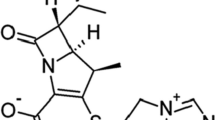Summary
A sensitive and reproducible method for the measurement of moxalactam in plasma and cerebrospinal fluid is described. Plasma proteins were removed by precipitation with ice-cold methanol at pH 5.6 and centrifugation. The supernatant was analysed by HPLC on a µ-Bondapack/phenyl column, with a mobile phase of acetonitrile/water/PIC Reagent A (20/80/1), and detection at 280 nm. The calibration curve was linear for plasma concentrations from 10 µg/ml to 60 µg/ml. Reproducibility was 4.7% (coefficient of variation) for within-day analysis and 13.8% for day-to-day analysis. Plasma concentrations in 9 moxalactam-treated patients with severe infections ranged from 0.9 µg/ml to 409 µg/ml. Individual pharmacokinetic parameters were calculated using a personal computer. In selected cases moxalactam concentrations were also determined in cerebrospinal fluid and tracheal aspirates.
Similar content being viewed by others
References
Appelbaum PC, Tamim J, Stravitz J, Aber RC, Pankuch GA (1982) Sensitivity of 341 non-fermentative gram-negative bacteria to seven beta-lactam antibiotics. Eur J Clin Microbiol 1: 159–165
Aronoff GR, Sloan RS, Mong SA, Luft FC, Kleit SA (1981) Moxalactam pharmacokinetics during hemodialysis. Antimicrob Agents Chemother 19: 575–577
Aronoff GR, Sloan RS, Luft FC (1982) Pharmacokinetics of moxalactam in patients with normal and impaired renal function. J Infect Dis 145: 365–369
Barry AL, Thornsberry C, Jones RN (1980) In vitro evaluation of LY 127935 (6059S) compared with cefotaxime, eight other β-lactams and two aminoglycosides. J Antimicrob Chemother 6: 775–784
Diven WF, Obermeyer BD, Wolen RL, Yu VL, Lyon J, Zuravleff J (1981) Measurement of serum and tissue concentration of moxalactam using high pressure liquid chromatography. Therap Drug Monit 3: 291–295
Freedman JM, Hoffman SH, Scheld WM, Lynch MA, da Silva HR, Rocha H, Sande MA (1983) Moxalactam for the treatment of bacterial meningitis in children. J Infect Dis 148: 886–891
von Hattingberg HM, Brockmeier D, Kreuter G (1977) A rotating iterative procedure (RIP) for estimating hybrid constants in multi-compartment analysis on desk computers. Eur J Clin Pharmacol 11: 381–388
von Hattingberg HM, Brockmeier D (1980) Drug concentration control and pharmacokinetic analysis during long term therapy with desk top computers. In: Gladtke E, Heimann G (eds) “25 Years of pharmacokinetics”. Fischer, Stuttgart, pp 165–179
von Hattingberg HM, Roos R, Brockmeier D, Marget W (1983) Die Ermittlung pharmakokinetischer Parameter aus Überwachungsprotokollen einer Sepsistherapie. Internist 24: 162–166
Jones RN, Packer RR (1982) Antimicrobial activity of amikacin combinations against Enterobacteriaceae moderately susceptible to third-generation cephalosporins. Antimicrob Agents Chemother 22: 985–989
Kaplan SL, Mason EO, Garcia H, Kvernland SJ, Loiselle EM, Anderson DC, Mintz AA, Feigin RD (1981) Pharmacokinetics and cerebrospinal fluid penetration of moxalactam in children with bacterial meningitis. J Pediatr 98: 152–157
Kaplan SL, Mason EO, Kvernland SJ, Loiselle EM, Feigin RD (1983) Moxalactam treatment of serious infections primarily due to Haemophilus influenzae Type B in children. Pediatrics 71: 187–191
Lam M, Manion CV, Czerwinski AW (1981) Pharmacokinetics of moxalactam in patients with renal insufficiency. Antimicrob Agents Chemother 19: 461–464
Landesman SH, Corrado ML, Cherubin CC, Gombert M, Cleri D (1980) Diffusion of a new beta-lactam (Ly 127935) into cerebrospinal fluid. Implications for therapy of gram-negative bacillary meningitis. Am J Med 69: 92–98
Latif R, Thirumoorthi MC, Buckley JA, Kobos DM, Aravind MK, Kauffman RE, Dajani AS (1981) Pharmacokinetics and clinical evaluation of moxalactam in infants and children. Dev Pharmacol Ther 3: 222–231
Marrie TJ, Haldane EV, Swantee CA, Kerr EA (1981) Susceptibility of anaerobic bacteria to nine antimicrobial agents and demonstration of decreased susceptibility of Clostridium perfringens to penicillin. Antimicrob Agents Chemother 19: 51–55
Martinez OV, Levi JU, Livingstone A, Malinin TI, Zeppa R, Hutson D, Einhorn N (1981) Biliary excretion of moxalactam. Antimicrob Agents Chemother 20: 231–234
Miner DJ, Coleman DL, Sheperd AMM, Hardin TC (1981) Determination of moxalactam in human body fluids by liquid chromatographic and microbiological methods. Antimicrob Agents Chemother 20: 252–257
Reed MD, Aronoff SC, Myers CM, Husak MP, Bertino JS Jr, Blumer JL (1983) Developmental pharmacokinetics of moxalactam. Antimicrob Agents Chemother 24: 383–387
Schaad UB, McCracken GH, Loock CA, Thomas ML (1980) Pharmacokinetics and bacteriological efficacy of moxalactam (LY 127935), netilmicin and ampicillin in experimental gramnegative enteric bacillary meningitis. Antimicrob Agents Chemother 17: 406–411
Schaad UB, McCracken GH, Loock CA, Thomas ML (1981) Pharmacokinetics and bacteriologic efficacy of moxalactam, cefotaxime, cefoperazone and rocephin in experimental bacterial meningitis. J Infect Dis 143: 156–163
Schaad UB, McCracken GH, Threlkeld N, Thomas ML (1981) Clinical evaluation of a new broad-spectrum oxa-beta-lactam antibiotic, moxalactam, in neonates and infants. J Pediatr 98: 129–136
Shelton S, Nelson JD, McCracken GH (1980) In vitro susceptibility of gram-negative bacilli from pediatric patients to moxalactam, cefotaxime, Ro 13-9904 and other cephalosporins. Antimicrob Agents Chemother 18: 476–479
Shimada J, Ueda Y, Yamaji T, Abe Y, Nakamura M (1980) Renal excretion of 6059-S, a new semisynthetic beta-lactam antibiotic. In: Nelson JD and Grassi C (eds) Current chemotherapy and infectious disease. American Societiy for Microbiology, Washington DC, p 109–110
Thirumoorthi MC, Buckley JA, Aravind MK, Kauffman RE, Dajani AS (1981) Diffusion of moxalactam into the cerebrospinal fluid in children with bacterial meningitis. J Pediatr 99: 975–979
Uwaydah MM, Jabbour N, Fahd S, Jaafar M, Faris BM (1982) Penetration of intravenous moxalactam into human aqueous humor. Arch Ophthalmol 100: 329–330
Wise R, Wright N, Wills PJ (1982) Activity, stability, and pharmacology of the epimers of moxalactam. Rev Infect Dis 4 [Suppl]: S564-S568
Wittmann DH, Schassan HH (1982) Distribution of moxalactam in serum, bone, tissue fluid, and peritoneal fluid. Rev Infect Dis 4 [Suppl]: S610-S616
Author information
Authors and Affiliations
Rights and permissions
About this article
Cite this article
Nielsen, J., Karlaganis, G., von Hattingberg, H.M. et al. High performance liquid chromatographic determination of moxalactam in human plasma and cerebrospinal fluid. Eur J Clin Pharmacol 29, 225–229 (1985). https://doi.org/10.1007/BF00547427
Received:
Accepted:
Issue Date:
DOI: https://doi.org/10.1007/BF00547427




